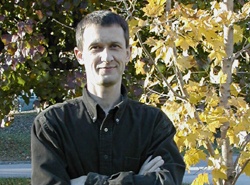Albrecht von Arnim, Ph.D. Lab Page
The past ten years have yielded surprising insights into the role of RNA in gene regulation. Protein synthesis (translation) remains poorly understood, although translational control affords a rapid means to amplify changes that occur at the level of transcription.
We are using the model system Arabidopsis thaliana, because of the excellent genetic resources available in this plant species. Moreover, few cases of translational control are well understood in plants. We developed a reporter gene system to monitor the translation status of specific genes in response to external signals such as light. We are combining this tool with mutations affecting individual translation initiation factors so as to assign specific functions to these proteins in translational control. Our data exemplify that generic initiation factors can contribute to the sequence-specific regulation of translational efficiency. Specifically, we implicated the H subunit of the largest initiation factor, eIF3, in the control of translation by upstream open reading frames, a type of regulatory device present in the 5’ leader of many mRNAs. Furthermore, we have learned how to use the toolkit of genomics, such as microarrays and bioinformatics, to survey the translation status of the entire set of cellular mRNAs. Experiments such as these are poised to reveal systematically which mRNAs are bundled together into regulons of translational control.
This work is helping us to understand how plants respond to their environment, has implications for the mechanisms of translational control in eukaryotes in general, and it may lead to novel ways to manipulate gene expression for the purpose of biotechnology.
Independently, we are engaged in developing biosensor technology for monitoring specific cellular events, in particular protein-protein interactions. To this end, we are harnessing a biophysical phenomenon, termed bioluminescence resonance energy transfer (BRET), which allows one to measure directly whether and when two proteins associate with each other in live organisms in real time. This and related biosensors are critical devices for the next phase of biology that we are about to enter.

1988 - MS, University of Freiburg, Germany
1992 - Ph.D., University of East Anglia and John Innes Institute, Norwich, United Kingdom
1992-1996 - Postdoctoral Fellow, Yale University, New Haven, CT
Contact Information
Albrecht von Arnim
Associate Professor
Department of BCMB
University of Tennessee
Knoxville, TN 37996
Phone: (865) 974-6206
Fax: (865) 974-0978
e-mail:vonarnim@utk.edu
Office:
Room 228
Hesler Biology
Lab:
Room 230
Hesler Biology

